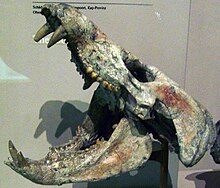Gomphodontia
| Gomphodonts | |
|---|---|

| |
| Skull of the gomphodont Diademodon tetragonus
| |
| Scientific classification | |
| Domain: | Eukaryota |
| Kingdom: | Animalia |
| Phylum: | Chordata |
| Clade: | Synapsida |
| Clade: | Therapsida
|
| Clade: | Cynodontia
|
| Clade: | †Cynognathia |
| Clade: | †Gomphodontia Seeley, 1895 |
| Subgroups | |
| |
Gomphodontia is a
cynodonts that includes the families Diademodontidae, Trirachodontidae, and Traversodontidae. Gomphodonts are distinguished by wide and closely spaced molar-like postcanine teeth, which are convergent with those of mammals. Other distinguishing characteristics of gomphodonts include deep zygomatic arches, upper postcanines with three or more cusps spanning their widths and lower postcanines with two cusps spanning their widths.[2] They are thought to have been herbivorous or omnivorous.[3] Gomphodonts first appeared in the Early Triassic and became extinct at the end of the Late Triassic
. Fossils are known from southern Africa, Argentina and southern Brazil (Paleorrota geopark), eastern North America, Europe, China, and Antarctica.
Gomphodontia was first named by paleontologist
eucynodonts (the other being Probainognathia
). Since then most studies have removed Tritylodontidae from Gomphodontia and reclassified it within Probainognathia as a group more closely related to mammals than are the convergently similar gomphodonts. Tritylodontoidea has fallen into disuse while Gomphodontia continues to be used in many studies.
Cladogram
Below is a cladogram from Ruta, Botha-Brink, Mitchell and Benton (2013) showing one hypothesis of gomphodont relationships:[7]
| Cynognathia |
| ||||||
